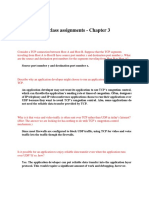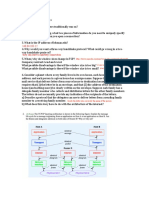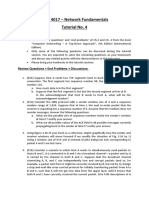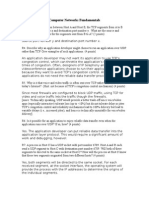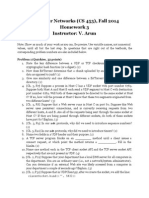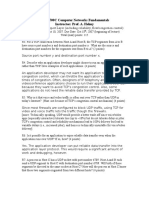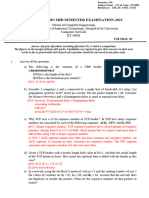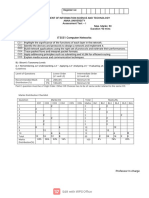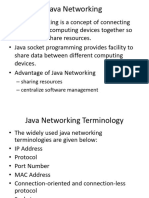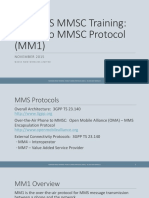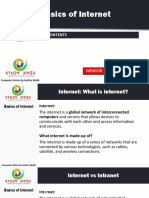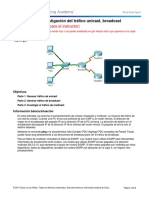Chapter 3 Review Questions
SECTIONS 3.1–3.3
R1. Suppose the network layer provides the following service. The network layer in the source host
accepts a segment of maximum size 1,200 bytes and a destination host address from the transport layer.
The network layer then guarantees to deliver the segment to the transport layer at the destination host.
Suppose many network application processes can be running at the destination host.
a. Design the simplest possible transport-layer protocol that will get application data to the desired
process at the destination host. Assume the operating system in the destination host has assigned a 4-
byte port number to each running application process.
b. Modify this protocol so that it provides a “return address” to the destination process.
c. In your protocols, does the transport layer “have to do anything” in the core of the computer
network?R2. Consider a planet where everyone belongs to a family of six, every family lives in its own
house, each house has a unique address, and each person in a given house has a unique name. Suppose
this planet has a mail service that delivers letters from source house to destination house. The mail
service requires that (1) the letter be in an envelope, and that (2) the address of the destination house
(and nothing more) be clearly written on the envelope. Suppose each family has a delegate family
member who collects and distributes letters for the other family members. The letters do not necessarily
provide any indication of the recipients of the letters.
a. Using the solution to Problem R1 above as inspiration, describe a protocol that the delegates can use
to deliver letters from a sending family member to a receiving family member.
b. In your protocol, does the mail service ever have to open the envelope and examine the letter in
order to provide its service?
R3. Consider a TCP connection between Host A and Host B. Suppose that the TCP segments traveling
from Host A to Host B have source port number x and destination port number y. What are the source
and destination port numbers for the segments traveling from Host B to Host A?
R4. Describe why an application developer might choose to run an application over UDP rather than
TCP.
R5. Why is it that voice and video traffic is often sent over TCP rather than UDP in today’s Internet?
(Hint: The answer we are looking for has nothing to do with TCP’s congestion-control mechanism.)
R6. Is it possible for an application to enjoy reliable data transfer even when the application runs over
UDP? If so, how?
R7. Suppose a process in Host C has a UDP socket with port number 6789. Suppose both Host A and
Host B each send a UDP segment to Host C with destination port number 6789. Will both of these
segments be directed to the same socket at Host C? If so, how will the process at Host C know that these
two segments originated from two different hosts?
�R8. Suppose that a Web server runs in Host C on port 80. Suppose this Web server uses persistent
connections and is currently receiving requests from two different Hosts, A and B. Are all of the requests
being sent through the same socket at Host C? If they are being passed through different sockets, do
both of the sockets have port 80? Discuss and explain.
SECTION 3.4
R9. In our rdt protocols, why did we need to introduce sequence numbers?
R10. In our rdt protocols, why did we need to introduce timers?
R11. Suppose that the roundtrip delay between sender and receiver is constant and known to the
sender. Would a timer still be necessary in protocol rdt 3.0, assuming that packets can be lost? Explain.
R12. Visit the Go-Back-N interactive animation at the companion Web site.
a. Have the source send five packets, and then pause the animation before any of the five packets reach
the destination. Then kill the first packet and resume the animation. Describe what happens.
b. Repeat the experiment, but now let the first packet reach the destination and kill the first
acknowledgment. Describe again what happens.
c. Finally, try sending six packets. What happens?
R13. Repeat R12, but now with the Selective Repeat interactive animation. How are Selective Repeat
and Go-Back-N different?
SECTION 3.5
R14. True or false?
a. Host A is sending Host B a large file over a TCP connection. Assume Host B has no data to send Host A.
Host B will not send acknowledgments to Host A because Host B cannot piggyback the
acknowledgments on data.
b. The size of the TCP rwnd never changes throughout the duration of the connection.
c. Suppose Host A is sending Host B a large file over a TCP connection. The number of unacknowledged
bytes that A sends cannot exceed the size of the receive buffer.
d. Suppose Host A is sending a large file to Host B over a TCP connection. If the sequence number for a
segment of this connection is m, then the sequence number for the subsequent segment will necessarily
be m + 1.
e. The TCP segment has a field in its header for rwnd.
f. Suppose that the last SampleRTT in a TCP connection is equal to 1 sec. The current value of
TimeoutInterval for the connection will necessarily be Ú 1 sec.
g. Suppose Host A sends one segment with sequence number 38 and 4 bytes of data over a TCP
connection to Host B. In this same segment, the acknowledgment number is necessarily 42.
�R15. Suppose Host A sends two TCP segments back to back to Host B over a TCP connection. The first
segment has sequence number 90; the second has sequence number 110.
a. How much data is in the first segment?
b. Suppose that the first segment is lost but the second segment arrives at B. In the acknowledgment
that Host B sends to Host A, what will be the acknowledgment number?
R16. Consider the Telnet example discussed in Section 3.5. A few seconds after the user types the letter
‘C,’ the user types the letter ‘R.’ After typing the letter ‘R,’ how many segments are sent, and what is put
in the sequence number and acknowledgment fields of the segments?
SECTION 3.7
R17. Suppose two TCP connections are present over some bottleneck link of rate R bps. Both
connections have a huge file to send (in the same direction over the bottleneck link). The transmissions
of the files start at the same time. What transmission rate would TCP like to give to each of the
connections?
R18. True or false? Consider congestion control in TCP. When the timer expires at the sender, the value
of ssthresh is set to one-half of its previous value.
R19. In the discussion of TCP splitting in the sidebar in Section 3.7, it was claimed that the response time
with TCP splitting is approximately 4 x RTT(FE) + RTT(BE) + processing time. Justify this claim.












